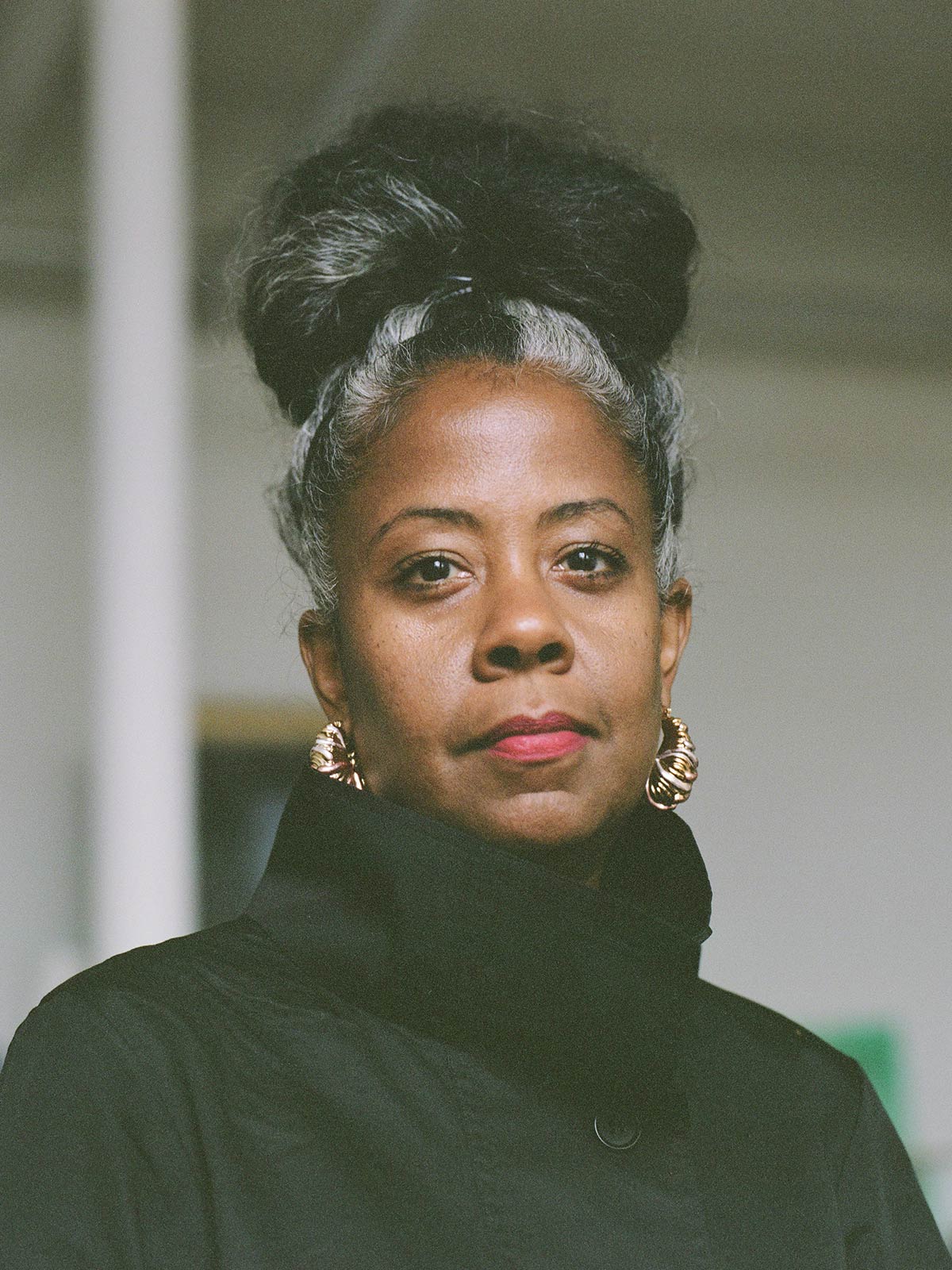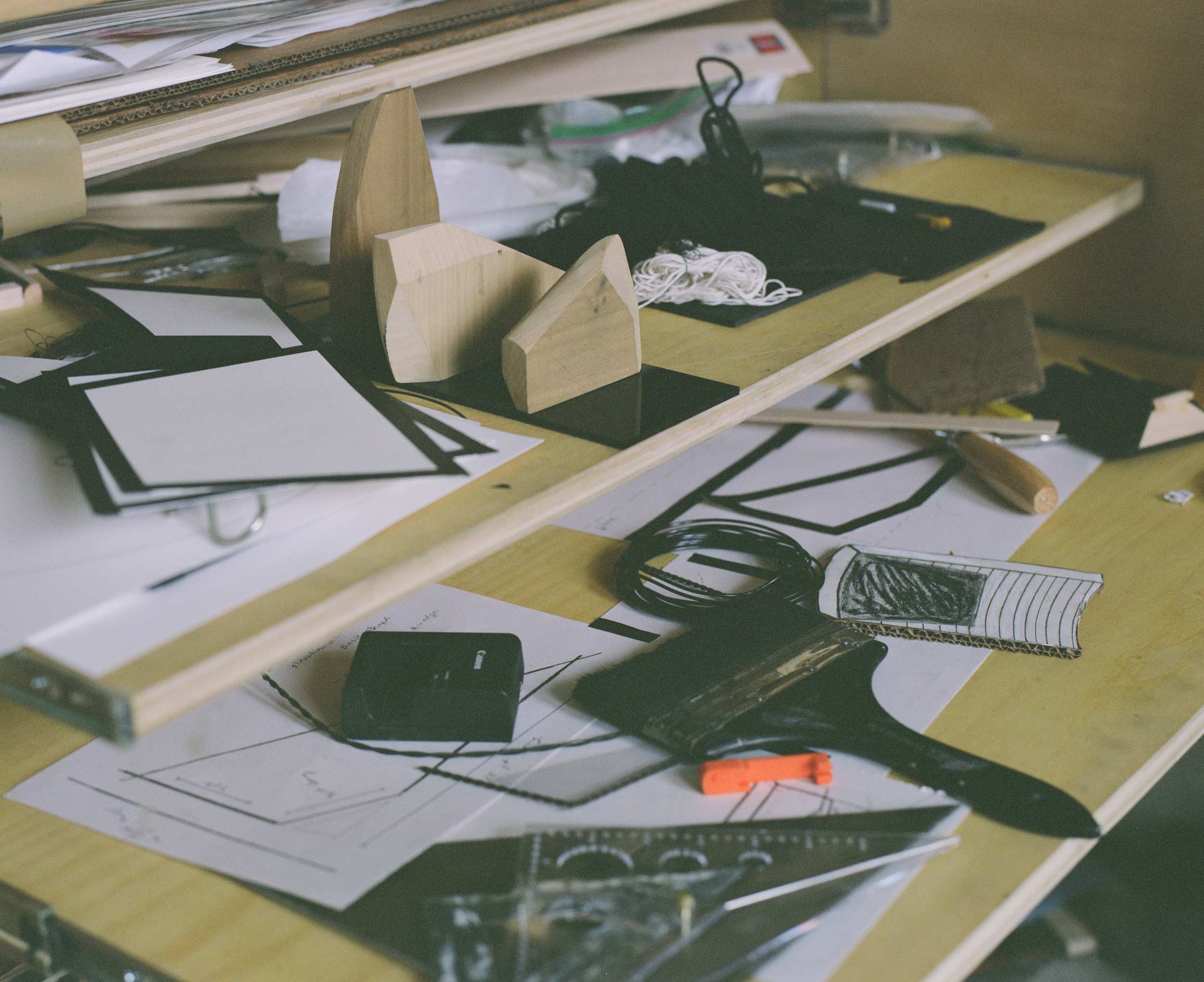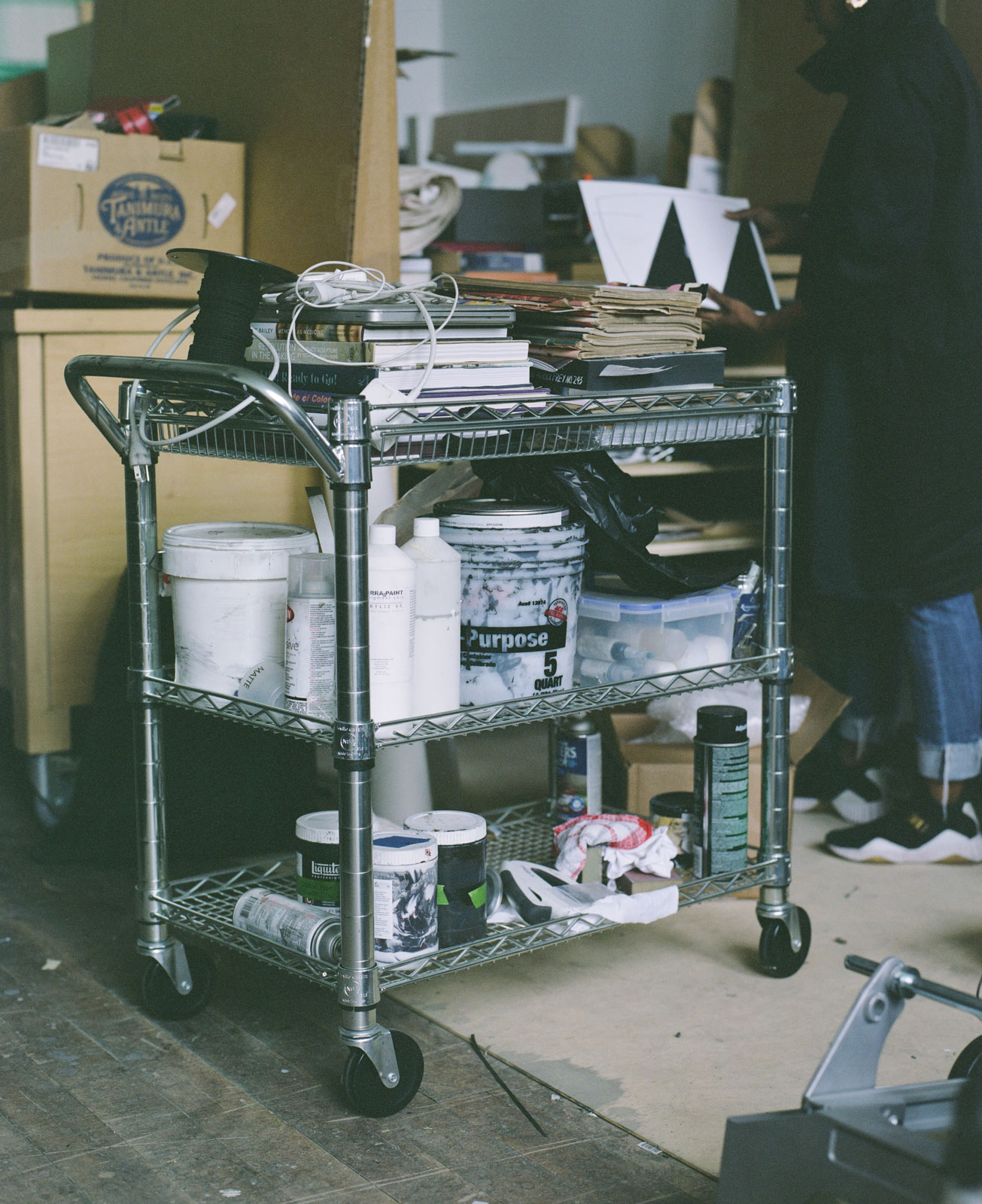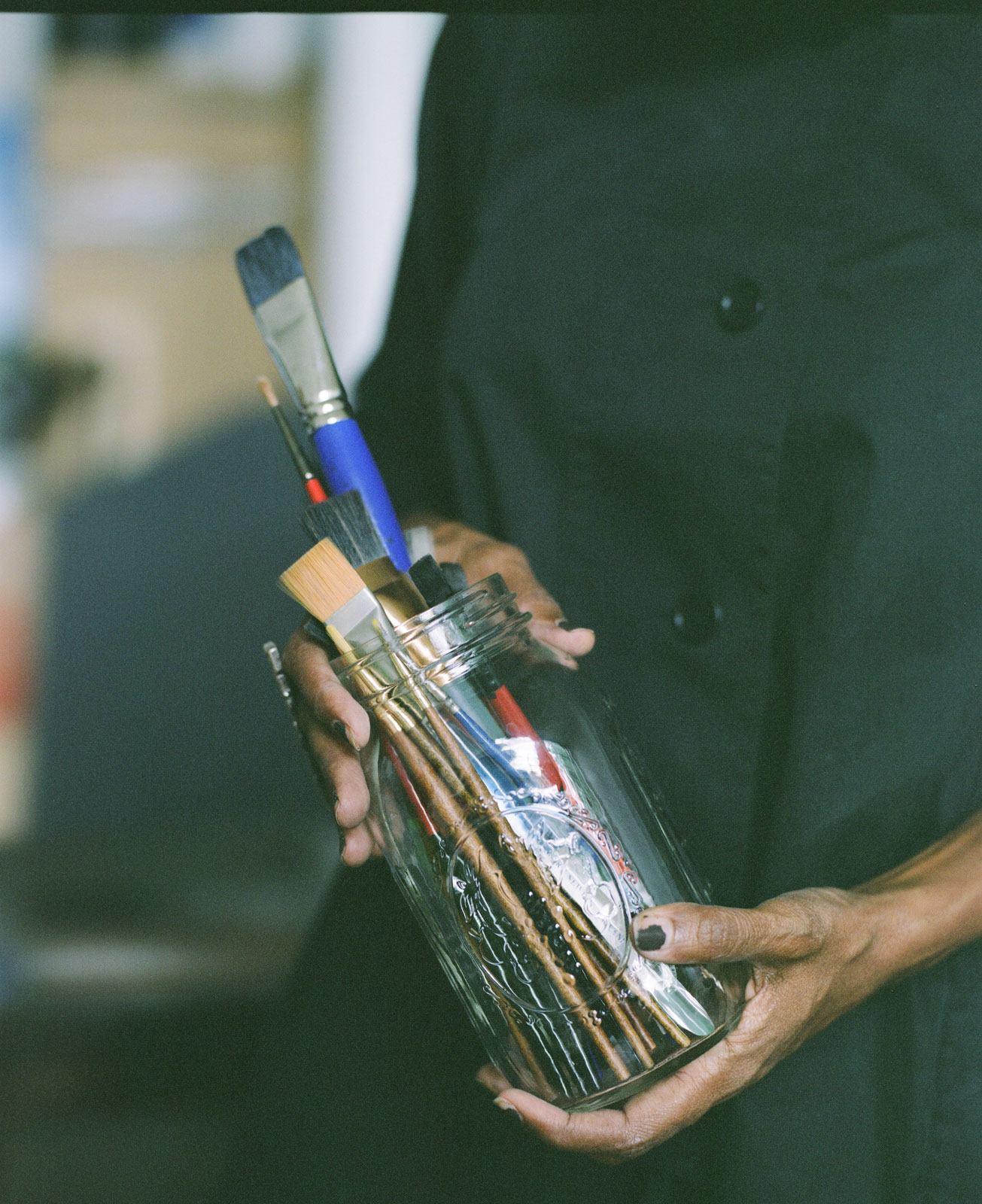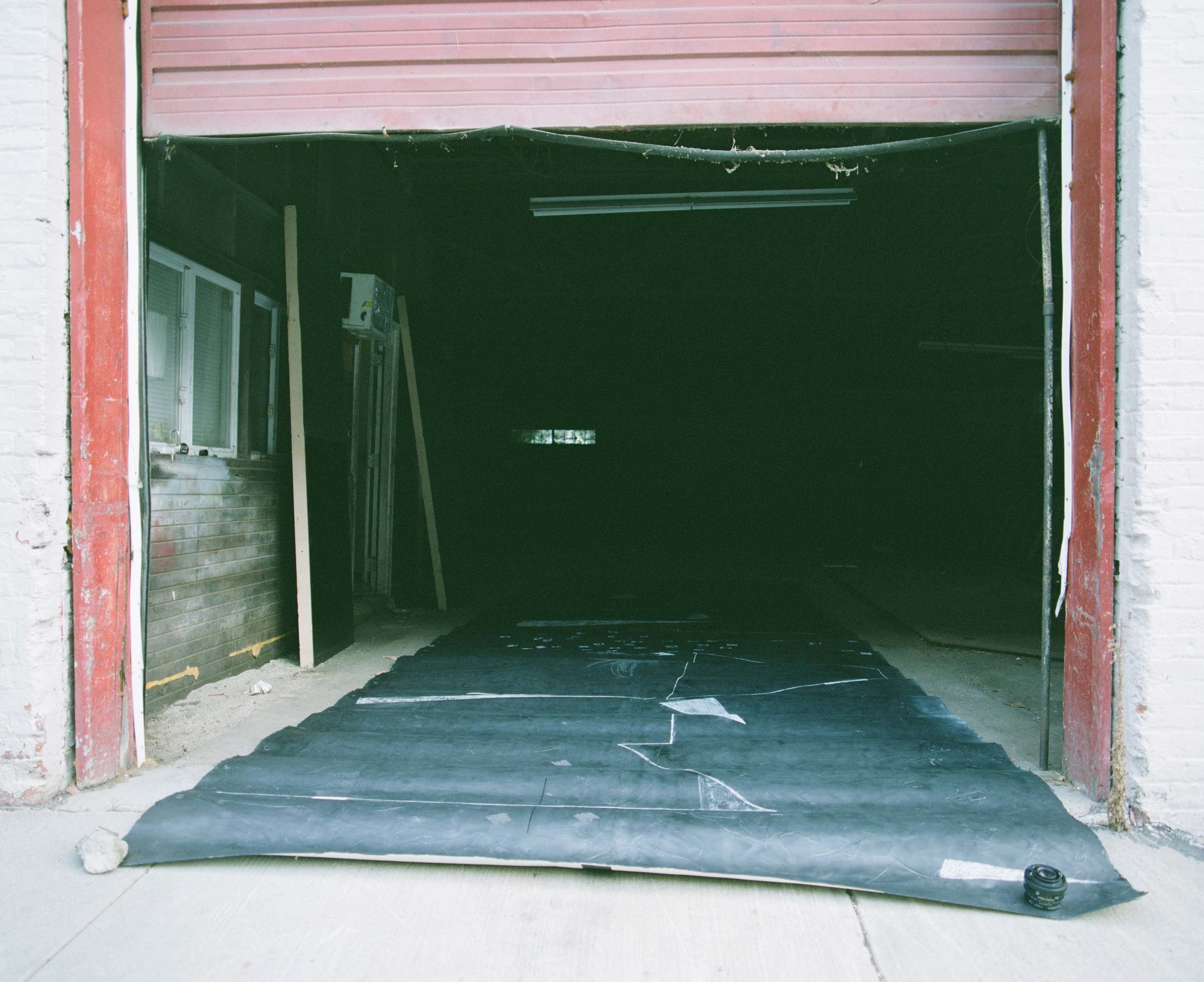100 years after the Red Summer riots, the artist subverts the notion that abstract painting is non-narrative in her new show ‘1919: Black Water.’
In her cartographic, atmospheric paintings, Torkwase Dyson organizes her artistic ideologies around architecture, geography, and blackness. Conceptually, the foundational geometric shapes that comprise Dyson’s works—the square, the curved line, and the triangle or trapezoid—are connected to the history of black resistance. For example, consider the story of Henry ‘Box’ Brown, an enslaved man who freed himself in 1849 by mailing himself in a crate to Philadelphia. Or Harriet Jacobs, who wrote in her 1861 narrative of her escape from slavery by hiding in a slant-roofed garret for the better part of a decade. “The garret was only nine feet long and seven wide,” she wrote. “The highest part was three feet high and sloped down abruptly to the loose board floor.” Dyson cites these shapes in her work because, historically, they have been instrumental to black resistance and liberation.
“We have a legibility problem,” Dyson declared during our discussion of her new solo exhibition, 1919: Black Water. The work includes drawings, paintings, and sculpture, which mark an incident in Chicago during the “Red Summer” of 1919. This was a time of intense racial violence and strife in the United States. Her statement about legibility could be interpreted as the perception by some that abstract art is impalpable. However, Dyson’s coded shapes and their approximation to the black body subvert the notion that abstraction is non-narrative. Below, the artist talks about the exploration of land and the body in her practice.
Monique Long—Can you expand further on the concept of what you’re working on?
Torkwase Dyson—You were there when I [was bringing out these ideas of] space, architecture and history. I’ve been working on that, expanding it with a lot of intention and finding all of these kinds of histories that help me explore that black spatial history. Architecture, infrastructure, capital, industry and industrial conditions all folded into each other. I feel like I have that down, these ideas. Now, when I choose a project, I know that [it deals with] those questions.
I got to the point in the paintings where I was aesthetically following those questions and then I hit a glass ceiling, a moment where I needed to push the form. Then I started to demand more of the materials. Because now I’m comfortably situated, I’m accepted, I’m proud of my infrastructural foundation, my conceptual substrate is solid. All I’m doing is digging and exploring deeper into what these paintings and sculptures are going to do.
The material, like graphite on canvas on acrylic, is new to this project. Understanding how to build a sort of [texture] on the surface does two things. It questions depth in the painting, space in the painting, gravity in the painting, visual and actual texture in the painting; it brings that question alivet, next to what I’ve been doing before; the washes, the lines, the diagrammatic moments, these very slow, kind of compositional, architecturally structured conditions. If I can have those, activate the painting in a two-dimensional space, together, and just dig into that, I will have really considered what ground and earth feels like in relationship to land and water, in relationship to architecture and infrastructure. That amalgamation is now happening and I’m just driving for it to be more poetic.
Monique—Can you talk more about the project and the title, this moment in United States’ history of 1919?
Torkwase—This is the 100th year anniversary of Red Summer, a summer where riots sprawled out [throughout the country from Chicago]. Because I’m from Chicago, I’m particularly interested in the incident that happened there, that was really set off by something that happened in the water. As you know, my main focus is in environmental issues and environmental conditions, climate change, global warming… as it pertains to sea levels rising. All that stuff in relation to black bodies and the Atlantic and crossing, those kinds of histories.
In that moment [1919], beaches were segregated. There were white beaches and black beaches, segregated, in Chicago. I heard this story that these five black boys had built a raft between the spaces, between Beach A and Beach B. They were in the water, they were swimming and being free, playing, thinking, communing and gathering around this raft. A white Chicagoan girl comes by and starts throwing rocks at them; they’re essentially being stoned. One Eugene Williams was hit in the head as he popped up in the water [and he subsequently died]. Initially, they’re not sure what’s going on because it was a space that they had called their own. When they realized what was happening, when Eugene was hit, they pulled him out of the water, they called the police, the police came and, of course, arrested the black men.
But what I’m interested in is the raft. I’m interested in those young brothas bringing materials from the train tracks over land, into the water, and making a space. I think about that as architecture, radical architecture—architecture that helps and allows bodies to be free, to self-express, to feel some autonomy inside of these white industrial terroristic systems. The show is really about what it means to think about architecture—specifically, about how black people make architecture of liberation that allows them some autonomy in-between these policies of racism and degradation. The raft was talked about very seldomly, because people focus on the riots, which they very well should. They focus on the systems and systemic orders that begot that. But that raft is also a system, right? It was also a choreographed condition that these young brothas had made for themselves…I grew up in East Chicago between South Shore and Hyde Park. So, I’m on Lake Michigan every day and I grew up on the beaches. When I heard this story, I thought, ‘I know that water.’ I’m interested in, ‘Could I have built a raft? Me and my girls, in the ‘80s, built a raft?’ I don’t know…but I just love that.
I’m interested in them [the young boys] as architects, engineers, people who sought out spaces between these kinds of conditions, which is a tertiary space, which is an interstitial space. I’m interested in that—the in-between.
Monique—It’s very interesting, too, because I remember from your last project, I Can Drink the Distance, you talked about these fundamental tenants of your practice, that you’re exploring over and over again: the curve, the box, and the triangle or the trapezoid. It’s surprising to hear you find that in that story, because obviously you focus on the abuse and the violence upon the black body. But you find the self-expression and the curve again of a raft—that can create a safe space and a source of joy for these boys before something horrible happens to them. So, here it is again, it carries through in a different way.
Torkwase—Yeah, I’m interested…and you know I’ve been talking about this idea of black compositional thought. And I have a definition for it.
Monique—I was going to ask you to define it.
Torkwase—I have a solid definition for it now. I’m very excited about it. I’m interested in that story, in Henry Box Brown, I’m interested in Harriet Jacobs, of course, which we talk about that all the time. I’m interested in how black people use space, both architecturally and within different kinds of infrastructure…You know, they [the boys] had a collective agreement around that raft. First of all, it was a secret. It was material. They had to—because of the way Chicago is geographically—they had to make scraps and bring them forward. They had to tie it up when they were gone; and tie it up secure so they would come back to sustain that level of freedom.
These boys, like Eugene Williams, practice what I call black compositional thought. My working term considers how paths, freeways, waterways, architecture, and geographies are composed by black bodies and how properties of energy, space, and objects interact as networks of liberation…It’s trying to negotiate what it means to have those multiple, radical conditions in space, particularly in this country, for brown and black bodies. Then those things act together. The raft is connected to the garret, the garret is connected to the box, the box is then connected to all kinds of moments on the Underground Railroad. If I go up to the lake now, I don’t see that raft, but the energy is there. That’s why I always include energetic, ancestral conditions as well. There’s no object, [but] there’s surely an ethos.
Monique—And that’s a kind of inheritance; it’s been passed down.
Torkwase—It. Is. Inheritance. That’s the point. One of my questions is, ‘How do we invent new aesthetic forms that are imbued with radical ancestorship, that address our insistence on liberated spatial practices? Can transformative modes of representing fugitivity also outline all these other things…migration…[and] shape how we think about climate migration and all things clandestine?’
Monique—Is this something that you ask yourself all the time? Or do you do it theoretically? Are you doing it as part of your process?
Torkwase—This is what I think and this is why it’s imbedded in the process: I think we have a legibility problem. I think that my abstractions are…there’s a range of existing in abstractions. There’s political abstraction, there’s social abstraction, environmental abstraction—all these umbrellas under abstraction… I think in geometric abstraction, it has to play in that register of politics for me, so that we understand how systems work. I think geometry is well suited to thinking about volume, and weight, and distance, and industry, and material, and space, and zoning…all of these things. I think we have a lot of work to do, as people who are in the business of thinking about systems. Toni Morrison brought up—well, she didn’t bring it up to me—the visual literacy around systems and systemic order. If you’re thinking about systems and systemic order, we don’t necessarily relate that to direct relationship to the body. But it’s all about the body, it’s all about how we negotiate the body. And then to take it to the plantation condition—then we can know through all of these underfunded [fields] of, I’ll say, geology, geography, and the other field that’s completely underfunded when it comes to plantations…[searches for word]
Monique—Archaeology?
Torkwase—Archaeology! Archaeologists know, from looking at plantations, where things were burned, where people were, [by looking at] those minerals. We have to figure out how to relay that to a painting language, and then associate that with those things. We can associate zoning, simultaneity, movement, architecture, infrastructure, decisions, all these things based on the hard sciences. These are all hard sciences that absolutely affect the social sciences. That’s what needs to be done. We need to work on our visual literacy around the physical sciences. Not that they lose the poetic—I’m interested in that, absolutely. We can do it all, we can handle it. But we have got to make a shift. I think for me, as a painter, to a kind of visual literacy that claims abstraction as having the potential to understand industrial white terror. Not just systemic, but industrial white terror. Spatially, how that might look. To get a sense of how that shit is going down.
Monique—Do you feel on a certain level that your abstraction has a narrative?
Torkwase—Absolutely! I think it has a narrative, it starts with a narrative. But this is a condition of Dionne Brand, where the narrative isn’t enough. Sometimes, the narrative isn’t enough, we need other things.
Monique—I think you used the expression at your talk, ‘to comprehend the incomprehensible.’
Torkwase—Yeah! To comprehend the incomprehensible. And, let me say, systemic order and industrialized white supremacy is a kind of incomprehensible condition if you only focus on the narrative of the black body. We’ll never really understand what a virus that is. I’m not talking to white people at all. Most of us aren’t. But I am talking to black people and saying, “How do we outmaneuver these sprawling industries in both a quotidian way and a phenomenological way?” If we can make paintings that deconstruct ideas of industrialized white supremacy on our terms, then things look different. Especially in climate change, especially when people of color are the most affected by water rising on the coast, water impurities, by industrial…
The center of Chicago was such an industrialized city, that [the boys from the Red Summer incident] were swimming in this place that they called ‘Hot and Cold.’ In an interview following Eugene’s death, and years later, one of the surviving members called it ‘Hot and Cold.’ They would get out and the water would change their bodies, so they looked almost pale. The toxicity that they were dealing with then!
Monique—At the first wave of the Industrial Revolution, there’s already…
Torkwase—The day was July 27, 1919—this was 1919! It’s [now] 100 years later. We have to think about abstraction as something that brings us closer to understanding who we are. Who are we right now? And what are we right now? What are we spatially? How do we think about maneuvering in these conditions that we don’t always control? How do we build strategies, like Eugene and his friends…and all the history of black self-liberation conditions…how do we do that? Is it a question of supporting black businesses? Is it a question of becoming more familiar with our own environmental uses of materials? Yes, it’s all of that, but it’s definitely a question of how we got here, how industry works. I’m interested in that kind of abstraction being about representation and narrative; and also saying that we need to add something to the aesthetic of black liberation [beyond representation and narrative]. I think someone like Mark Bradford is doing it, Julie Mehretu is doing it, and doing it in specific ways. I felt like there was room for me to do [that] specifically around climate change and water. We’ll see, you know? We’ll see where it goes. Because, you know, black people are always building architecture around water, near water, around water.
So, that’s it, that’s the plan.
“1919: Black Water” opens at Columbia University, Arthur Ross Architecture Gallery, 515 West 116th St, New York, NY 10027, Friday September 27, 2019 at 6pm.
Monique Long is a curator and writer based in New York.


